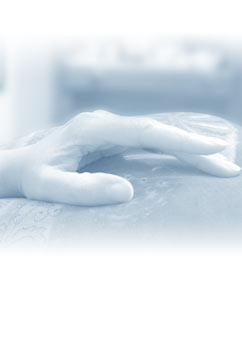The NeuroBehavioral Pain Management Program is a holistic behavioral medicine program that uses language to direct the processes that control the subjective experience of acute and chronic pain. Taught by a trained clinician and in conjunction with appropriate medical supervision, NeuroBehavioral Pain Management Program techniques have proven to reduce pain effectively in more than 90% of chronic pain cases and to reduce the symptoms and medication needs of chronic sufferers.
The Pain Management Program guides patients through three levels of skill. Because the three-level program is built on progressive success, it usually takes as little as three sessions to complete. The self-administered pain relief procedures can easily be taught to children and the elderly. The treatment targets all aspects (bio-psycho-social) of the chronic pain cycle, often changing patients' relationship to pain as they are able to gain control of their symptoms. Patients also report that the training is effective in reducing the depression that frequently accompanies chronic pain and physical disability.
Scientific Background
Changing Models of Body-Mind Interaction
Beginning with the Relaxation Response in the seventies and continuing through the adoption of the bio-psycho-social model of patient care in the eighties and the developing field of psycho-neuro-immunolgy in the nineties, models of body-mind interaction have evolved to describe how a patient’s thoughts, feelings, and actions effect changes in the physical body.
Thousands of research studies have described the effects of body-mind interaction. And while the general concept of body-mind interaction is widely taken for granted and has become part of popular language, the psychological or neuroscience theories and concepts needed to explain how the mind and body communicate and interact are seldom presented. This section aims to introduce you to a number of scientific concepts that explain how NeuroBehavioral Programs may work.
NeuroBehavioral Programs use naturally occurring psychophysical processes to train a patient to establish conscious control of pain, stress, negative emotions, and other conditions for life enhancement.
The central concepts underlying NeuroBehavioral Programs include:
- ideomotor action
- information transduction
- operant conditioning
- auto-associators
- global neuronal workspace theory (Baars, 1998)
Based on these concepts, the NeuroBehavioral Pain Management Program establishes body-mind feedback systems to create the neural connections needed for establishing conscious control of pain, stress, and negative emotions. First, several verbal commands are used, and then abbreviated cognition and ultimately simple focal awareness trigger the desired symptom reduction. What follows is a general description of the concepts and how they interrelate.
Recent findings derived through PET scanning and functional MRI (fMRI) studies show that imagined motor action in the mind is processed in the same neural substrate as executed action in the body. For example, if we vividly imagine sitting on a tropical beach, our mind may process this image in the body as if we were actually there, creating a feeling of calm. This natural body-mind process is called ideomotor action. This concept may help explain such body-mind effects as anticipatory anxiety, the motor response in dreaming, guided imagery, and the placebo effect.1
The process of information exchange in ideomotor action is called information transduction and is thought to be carried out by messenger molecules, peptides, and other neurotransmitters.2
These processes operate within what a larger umbrella theory calls global neuronal workspace.3 This theory suggests that under certain conditions, if we make a problem-solving command to the body — for example, to become able to reduce pain — the command is broadcast like a television signal to all the interconnected neural structures required to give us the desired outcome. All of this takes place outside of our awareness, without conscious effort on our part. Once a desired outcome has been created through this neural transmission, according to this "everything-is-connected-to-everything-else" model, redundant neural connections are formed that through repeated use may create what is a called an auto-associator within a large interconnected neural network.4
Once an outcome is neurally established, if only a part of a pattern is presented to an auto-associator, the rest of the pattern can be recalled or initiated. (Think of the TV program "Name That Tune" — "I can do this in three notes.")
The concept of an auto-associator, when paired with the learning principle of operant conditioning, may explain how NeuroBehavioral Pain Management Program patients have been trained to create a growing capacity to effect physiological changes using fewer and fewer cues. The four skill levels of conscious symptom control that patients are trained in are as follows:
- Level 1 — uses three verbal commands, which over time can evolve into…
- Level 2 — uses two verbal commands, which evolves into…
- Level 3 — uses a single cognitive command to control pain
(At Level 4, which patients in the program are not typically trained in, focal awareness of the symptom can be conditioned as a cue to initiate the symptom reduction action.)
The approximate times required to achieve these levels are as follows:
- Level 1 — 45 minutes, using the audio CD
- Level 2 — 15 minutes, using two memorized sentences for each of four symptoms
- Level 3 — 5 to 10 minutes, using one command for each of four symptoms
- Level 4 — Immediate changes, triggered by focal awareness
![]() Physicians'
and Therapists' FAQ
Physicians'
and Therapists' FAQ
1 Abstract from the article "Ideomotor Action and Imitation," Robin Allott, ESSCS St. Maximin, Provence April 1996. You can view this and other related articles at http://www.percepp.demon.co.uk.
2See Ernest Rossi's, "New Concepts of Therapeutic Hypnosis for detailed information on information transduction."
3"In the Theater of Consciousness," Bernard J. Baars, Journal of Consciousness Studies, 4, No. 4, 1997, pp.292-309.
4For an overview of auto-associators and neural networks see Stephan Pinker's, How the Mind Works.

